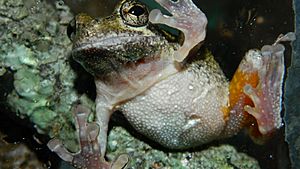Cope's gray treefrog facts for kids
Quick facts for kids Cope's gray tree frog |
|
|---|---|
 |
|
| Conservation status | |
| Scientific classification | |
| Kingdom: | |
| Phylum: | |
| Class: | |
| Order: | |
| Family: | |
| Genus: | |
| Species: |
H. chrysoscelis
|
| Binomial name | |
| Hyla chrysoscelis Cope, 1880
|
|
The Cope's gray tree frog (Hyla chrysoscelis) is a type of tree frog that lives in the United States. It is also known as the southern gray tree frog. This frog looks very much like another frog called the gray tree frog (Hyla versicolor). They even live in many of the same places.
Both types of gray tree frogs can change their color. They are often mottled gray or gray-green, which helps them blend in with tree bark. These frogs usually live in forests. However, they sometimes travel to open areas to find ponds for breeding.
The easiest way to tell the two species apart is by their calls. Cope's gray tree frog has a faster and slightly higher-pitched call. Cope's gray tree frog is also said to be a bit smaller. It spends more time in trees and can handle dry conditions better than H. versicolor. Without hearing their calls or knowing their exact location, it is very hard to tell these two frog species apart.
Contents
About Cope's Gray Tree Frog
Naming the Frog
Edward Drinker Cope first described this frog species in 1880. The scientific name chrysoscelis comes from two Greek words. Chrysos means "gold" and scelis means "leg."
Frog DNA: Chromosomes
Scientists have looked closely at the chromosomes of H. chrysoscelis and H. versicolor. They found differences in the number of chromosomes. H. chrysoscelis is diploid. This means it has two full sets of chromosomes, which is normal for animals with backbones.
However, H. versicolor is tetraploid. This means it has double the usual number of chromosomes. Scientists believe H. versicolor likely developed from H. chrysoscelis. This probably happened during the last big ice age. Very cold areas separated groups of frogs, leading to new species. Even though they now live in the same places, these two frog species usually do not breed with each other.
What Does It Look Like?
Both Cope's gray tree frog and the gray tree frog have bright orange patches on their back legs. This helps tell them apart from other tree frogs, like H. avivoca. The bright orange color is usually hidden. But when the frog jumps, the color flashes. This "flash pattern" probably helps to surprise a predator as the frog escapes. Some moths, like those in the Catocala genus, use similar hidden bright patterns.
Both types of gray tree frogs show slight differences between males and females. During the breeding season, male frogs have black or gray throats. Female frogs have lighter-colored throats.
Where Do They Live?
The Cope's gray tree frog usually lives in more southern areas. It is often found in the lower parts of the Piedmont and Coastal Plain in Virginia and the Carolinas. In these areas, the gray tree frog (H. versicolor) might only live in the Appalachians.
The bird-voiced tree frog (H. avivoca) looks similar to the gray tree frogs. But it is smaller, measuring about 25–50 mm long. Gray tree frogs are usually 32–62 mm long.
How Do They Behave?
In the southeastern United States, Cope's gray tree frog breeds and calls from May to August. When the weather gets warm, male frogs start calling from wooded areas. They do this a week or more before moving to temporary ponds to breed. At the ponds, many males gather and call together.
They call most often at night. But individual frogs will often call during the day if they hear thunder or other loud noises. Female frogs lay their eggs in groups of 10 to 40. They place them on the surface of shallow ponds and other small bodies of water. These temporary waters usually do not have fish. The eggs hatch in about five days. The young frogs then take about 45–65 days to change into adult frogs.
Cope's gray tree frog can survive in very cold temperatures, even as low as –8 °C (17.6 °F).
Images for kids
See also
 In Spanish: Hyla chrysoscelis para niños
In Spanish: Hyla chrysoscelis para niños






